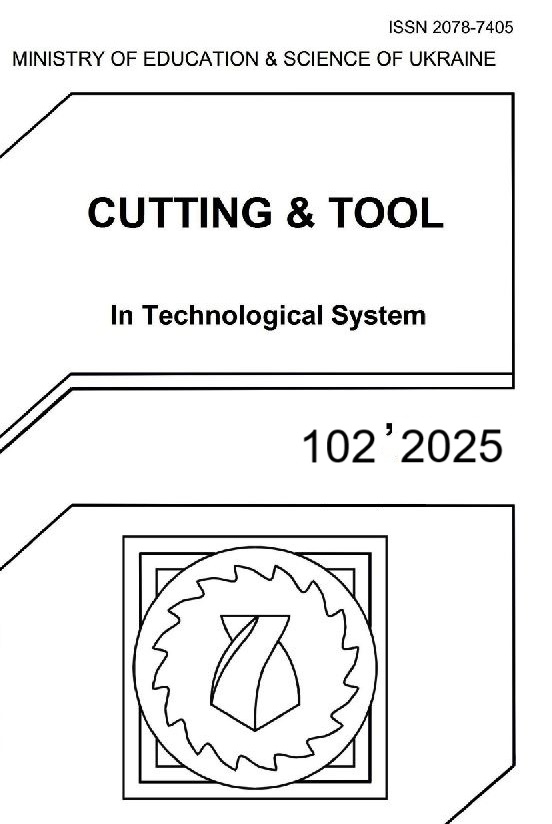FORM ACCURACY AND CUTTING FORCES IN TURNING OF X5CRNI18-10 SHAFTS: A STUDY ON CYLINDRICITY, COAXIALITY, STRAIGHTNESS, AND WAVINESS AT SMALL FEEDS
DOI:
https://doi.org/10.20998/2078-7405.2025.102.08Keywords:
turning, cutting parameters, cutting forces, cylindricity, straightness, wavinessAbstract
This paper investigates how the cutting speed (vc), feed rate (f) and depth of cut affects the cutting forces and the quality of the surface during turning operations. For the study different experiments have been performed at two depths of cut (0.5 mm and 1.0 mm) to observe how they affect the cutting force, cylindricity, coaxiality (COAX DIN), straightness and waviness. From the results it can be said that the cutting forces and surface deviations increase with the increase in depth of cut. Cutting force normally brings down the forces and enhances surface quality but feed rate has exactly opposite impact. Thus, it is necessary to choose parameters wisely to keep machining efficiency and dimensional accuracy in balance.
References
Petropoulos, G.; Pandazaras, C.; Davim, J. P. Surface integrity in machining. In Surface Integrity in Machining 2010. https://doi.org/10.1007/978-1-84882-874-2_2
Kalpakjian, S.; Schmid, S.; Sekar, V. Manufacturing engineering and technology. 2013.
Altintas, Y.; Ber, A. A. Manufacturing automation: Metal cutting mechanics, machine tool vibrations, and CNC design. Applied Mechanics Reviews 2001, 54. https://doi.org/10.1115/1.1399383
Campos, P. H. S.; Davim, J. P.; Ferreira, J.; Paiva, A.; Balestrassi, P. The machinability of hard materials – A review. In Machinability of Advanced Materials 2014. https://doi.org/10.1002/9781118576854.ch5
Nouari, M.; List, G.; Girot, F.; Coupard, D. Experimental analysis and optimisation of tool wear in dry machining of aluminium alloys. Wear 2003, 255, 1359–1368. https://doi.org/10.1016/S0043-1648(03)00105-4
Ghani, J. A.; Haron, C. H. C.; Kasim, M. S.; Sulaiman, M. A.; Tomadi, S. H. Wear mechanism of coated and uncoated carbide cutting tool in machining process. Journal of Materials Research 2016, 31, 1873–1879. https://doi.org/10.1557/jmr.2015.382
Kaladhar, M.; Kambagowni, V.; Rao, C. S. Machining of austenitic stainless steels – A review. International Journal of Machining and Machinability of Materials 2012, 12, 178–192. https://doi.org/10.1504/IJMMM.2012.048564
Kovalchenko, A. Studies of the ductile mode of cutting brittle materials (A review). Journal of Superhard Materials 2013, 35. https://doi.org/10.3103/S1063457613050018
Adesta, E.; Riza, M.; Al Hazza, M.; Agusman, D.; Rosehan, R. Tool wear and surface finish investigation in high speed turning using cermet insert by applying negative rake angles. European Journal of Scientific Research 2009, 38, 180–188.
Grzesik, W. Advanced machining processes of metallic materials: Theory, modelling, and applications, 2nd ed.; Elsevier, 2016.
Özel, T. Predictive modeling of surface roughness and tool wear in hard turning using regression and neural networks. International Journal of Machine Tools and Manufacture 2005, 45, 467–479. https://doi.org/10.1016/j.ijmachtools.2004.09.007
Ozcelik, B.; Bayramoğlu, M. The statistical modeling of surface roughness in high-speed flat end milling. International Journal of Machine Tools and Manufacture 2006, 46, 1395–1402. https://doi.org/10.1016/j.ijmachtools.2005.10.005
Saini, S.; Ahuja, I.; Sharma, V. The effect of cutting parameters on surface integrity in hard turning. Applied Mechanics and Materials 2011, 110–116, 751–757. https://doi.org/10.4028/www.scientific.net/AMM.110-116.751
Benardos, P. G.; Vosniakos, G. C. Predicting surface roughness in machining: A review. International Journal of Machine Tools and Manufacture 2003, 43, 833–844. https://doi.org/10.1016/S0890-6955(03)00059-2
Dogra, M.; Sharma, V. S.; Dureja, J. Effect of tool geometry variation on finish turning – A review. Journal of Engineering Science and Technology Review 2011, 4, 1–13. https://doi.org/10.25103/jestr.041.01
Padhan, S.; Wagri, N.; Dash, L.; Das, A.; Das, S.; Rafighi, M.; Sharma, P. Investigation on surface integrity in hard turning of AISI 4140 steel with SPPP AlTiSiN coated carbide insert under nano MQL. Lubricants 2023, 11, 49. https://doi.org/10.3390/lubricants11020049
Sivaprakasam, T.; Hasan, S. Machinability of hard martensitic stainless steel and hard alloy steel by CBN and PCBN tools by turning process. Proceedings of the World Congress on Engineering 2011, 1
Downloads
Published
Issue
Section
License
Copyright Notice
Authors who publish with this Collection agree to the following terms:
1. Authors retain copyright and grant the Collection right of first publication with the work simultaneously licensed under a Creative Commons Attribution License that allows others to share the work with an acknowledgement of the work's authorship and initial publication in this Collection.
2. Authors are able to enter into separate, additional contractual arrangements for the non-exclusive distribution of the Collection's published version of the work (e.g., post it to an institutional repository or publish it in a book), with an acknowledgement of its initial publication in this Collection.
3. Authors are permitted and encouraged to post their work online (e.g., in institutional repositories or on their website) prior to and during the submission process, as it can lead to productive exchanges, as well as earlier and greater citation of published work.

